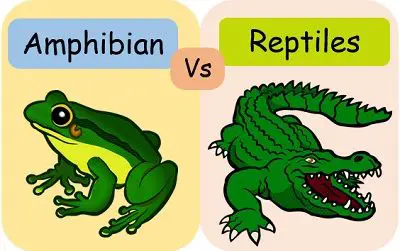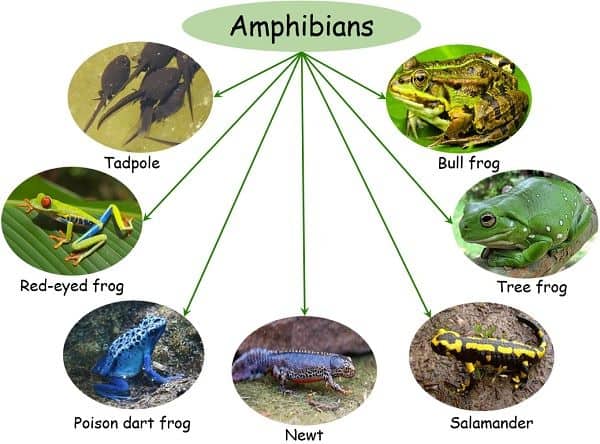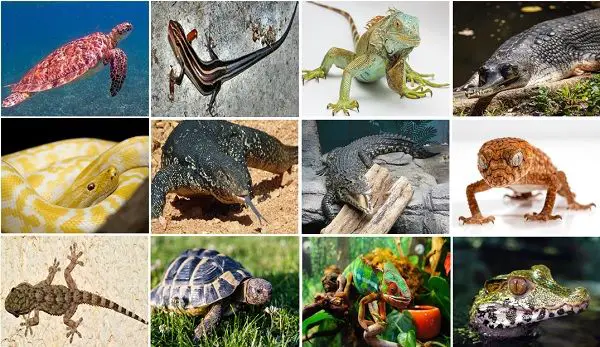Both the amphibians and reptiles belong to the phylum chordate, thereby having well defined vertebral columns. But still, they greatly differ in their living habits, structure, reproduction cycle and even habitat.
The class amphibians comprise the animals like toads, frogs, and salamanders. They can survive easily on land and water as they have optional gills or porous skin to breathe along with lungs. Whereas the class Reptilia include snakes, lizards, and turtles. They are strictly restricted to the land because they only comprise lungs.
The skin of an amphibian is soft, delicate, moist, thin, semi-permeable and porous. In contrast, the skin of the reptiles is hard, scaly, dry, thick, and with no pores.
Another significant difference between amphibians and reptiles is the circulatory system. On the one hand, the amphibians have a partially divided atrium due to which only partially oxygenated blood circulates within their body. In comparison, the reptiles have a properly divided atrium which supports the aerated blood flow throughout their body.
Due to the porous skin of amphibians, they are extremely susceptible to environmental toxins, especially in water. Whereas because of the thick, hard and impermeable skin layer of the reptiles, they remain protected from the pollutants and toxins of the environment.
Here, we will discuss the major differences between amphibians and reptiles along with a comparison chart, characteristics and examples.
Do you know?
- The branch of zoology that deals with the study of the reptiles and amphibians is Herpetology.
- The persons who study and research reptiles and amphibians are Herpetologists.
- Herpetoculture refers to keeping reptiles and amphibians as a hobby or for commercial benefits.
Content: Amphibians Vs Reptiles
Comparison Chart
| Basis for Comparison | Amphibians | Reptiles |
|---|---|---|
| Meaning | Amphibians are ectothermic or cold-blooded animals, living on land or in water. They use gills as well as lungs for breathing, in water and on land respectively. | Reptiles are also one of the ectothermic or cold-blooded animals, which live on land. They can be oviparous or viviparous and have four legs. |
Dwelling/Habitat | These animals live in the aquatic environment as well as on land. Their larval stage is spent in water and adulthood on land. | Reptiles live on land (terrestrial animal), but some of them like alligators, turtles and crocodile can live in water also. |
| Examples | Toads, Frogs, Salamanders, etc. | Snake, Lizards, Crocodile, etc. |
| Mode of reproduction | They are oviparous, in which embryos develop inside the mother's womb in the egg and are hatched outside the mother's body. | Some animals are oviparous, while some are viviparous(embryos get develop inside the mother's womb). |
| Type of fertilization | External. | Internal. |
| Other features | Amphibians can breathe in both ways, which can be through gills or from the lungs. | Reptiles breathe only through lungs. |
| They have the restriction of visualising certain colours, which means they have the restriction to narrow bands of the colour spectrum. | Reptiles have a wide range of colour spectrum and can visualize and distinguish different colours. | |
Amphibians have a three-chambered heart. | Reptiles also have a three-chambered heart, but their ventricle is further divided through a septum. | |
Amphibians secrets toxins from their skin, which protect them from predators. | Reptiles have hard scales and protection all over their skin; they also produce toxins from teeth and nails. | |
Smooth, sticky, moist and highly porous skin to perform the various function. | They have dry, hard and scaly skin, which protects them. |
|
Amphibians lay their eggs in water which are covered with gel. | Reptiles lay their eggs on land and have a hard protective covering. | |
| They have webbed feet, which help them in swimming and jumping. | These have four limbs, helping them in running and swimming, while snakes do not have limbs and they crawl. |
What are Amphibians?
There are around 3000 different species of amphibians existing on the planet. They are unique due to their dual life both as aquatic and terrestrial creatures.
They are cold-blooded vertebrates that are present either on land or in freshwaters.
Lifecycle of an Amphibian
Almost all of them have two distinct phases of their life cycle. The amphibian must spend one phase of its lifecycle in water.
The first phase is the larval phase, where they are present in fish-like aquatic creatures. In the second phase, it acquires maturity and becomes an adult. As soon as it transforms into an adult, it moves to its terrestrial habitat. Later, they again come back to the water at the time of breeding.
They lay the eggs and sperm in the water and get fertilised. Further, the fertilised egg gives rise to a tadpole larva.
Types of Amphibians
There are three prominent types of the amphibians:
- Tailless frogs or toads (Anura)
- Tailed newts and salamander (Urodela)
- Limbless burrowing forms
Common Examples of Amphibians
- Rana (Frog)
- Alytes (Midwife toad)
- Hyla (Tree frog)
- Bufo (toad)
- Pipa (Surinam toad)
- Ichthyophis
- Salamander
- Rhacophorus
General characteristics of the Amphibians
- They consist of a largemouth having small teeth. These teeth are least used as they usually swallow their food as a whole.
- Their skin is highly thin, delicate, hairless, moist and naked without any exoskeleton. It consists of several mucous and poison glands.
- The single vertebrae of the neck region limit the articulation of the head.
- There are ten pairs of cranial nerves that originate from the brain.
- Have a pair of eyes with movable eyelids and coloured vision. But this vision remains limited up to a certain range of colours only.
- They are unisexual organisms and undergo external fertilisation.
- The adults are tetrapods bearing four distinct limbs.
- The forelimbs have four while the hind limbs bear five digits without claws.
- Hind limbs are strong, long and comparatively more powerful in anura. These limbs facilitate their jumping and swimming.
- While in newts and salamanders, both of the limbs are equal.
- Especially the tongue of frogs and toads remains anteriorly attached and posteriorly free. Because of this, the tongue launches quickly to capture the flying prey.
- Their ear possesses a specialised outer membrane named the tympanum, which aids their hearing mechanism.
- They have three-chambered hearts having two auricles and a ventricle.The heart of the tadpole is two-chambered.
Adaptations in Amphibians
The amphibians are capable of living efficiently on both land and water. In order to attain this unique ability, they have undergone several adaptations that make this dual survival process easy.
Adaptation for terrestrial life
- Lungs are present in adults to respire on the land.
- Hind limbs are strong and long, which helps them in jumping high.
- They lack the neck region in order to protect it while jumping.
- Camouflaging skin colour is a defensive trait that protects them from predators.
Adaptations for aquatic life
- Their body form is spindle-shaped, making it easier to swim.
- Gills are present to breathing inside water.
- In a case where the gills are not present cutaneous respiration occurs via a moist skin layer.
- Their eyes have a protective nictitating membrane.
- They possess webs between subsequent digits of hind limbs that help to swim.
What are Reptiles?
You can easily find reptiles creeping and crawling on the ground. The majority of the species belonging to class Reptilia are already extinct, such as dinosaurs, while a very small proportion are left alive, including snakes, lizards, tortoises etc.
Around 6000 species of reptiles exist, including snakes, lizards, turtles, crocodiles etc.
Examples of some common Reptiles
- Hemidactylus (Common wall lizard)
- Calotes (garden lizard)
- Chameleon
- Draco (Flying lizard)
- Varanus (Monitor lizard)
- Uroma-stic (Sand lizard)
- Naja (Cobra)
- Crotalus (Rattlesnake)
- Python (Ajgar)
- Hydrophis (Sea snake)
- Gravialis (Gharial)
- Alligator
- Testudo (Tortoise)
General Characteristics of Reptilia
- Their skin is hard, scaly, dry, thorny and impervious in nature. Like snakes and lizards, some of the species shed their scale as a skin cast at regular intervals of time.
- Reptiles have watertight skin because of the horny epidermis layer.
- They are also tetrapods with pentadactyl limbs, each having five digits ending in a claw.
- Respiration strictly occurs via the lungs.
- They bear a three-chambered heart with a complete division of the chambers by septum. But the crocodiles are the only reptiles that have four-chambered hearts.
- They are poikilothermal or cold-blooded organisms that are unable to regulate their body temperature by themselves.
- They are mainly terrestrial, but some can also survive underwater for some time.
- Possess nucleated red blood cells.
- The body consists of three distinct regions- head, trunk and tail.
- These are unisexual organisms. The fertilisation process takes place internally.
- Most of them are oviparous, except for snakes that are viviparous.
- They have adapted their vision according to daylight. Their visual depth perception is highly advanced than that of amphibians and mammals.
- Possess a large cerebellum and cerebrum with twelve pairs of cranial nerves.
- They shed their tail as a defence mechanism.
Reproduction in Reptiles
Generally, most of them reproduce sexually, but some can even reproduce asexually. The fertilisation of the egg occurs internally. They lay eggs and thereby are oviparous.
All the activities related to reproduction take place inside the cloaca.
It is the single exit/ entrance at the base of the tail, which also serves as the outlet for the waste. The female delivers the egg via cloaca.
All reproductive activity occurs within the cloaca, the single exit/entrance at the base of the tail where waste also leaves the body. Eggs leave the female’s body through the cloaca.
Adaptations in Reptiles
- The skin is dry and impermeable for penetration.
- Adhesive glands are present at the base of the claws, which help in clinging and climbing the walls.
- Well-developed lungs are there for respiration.
- The burrowing reptiles lack limbs.
- Aquatic snakes bear flat tails to help them swim.
Key Differences Between Amphibians and Reptiles
Structural Differences
- Amphibians have smooth, sticky, moist and highly porous skin to perform various functions. In comparison, reptiles have dry, hard and scaly skin, which guard them in harsh condition.
- Amphibians have the limitation of visualising certain up to narrow bands of the colour spectrum. On the other hand, reptiles have a wide range of colour spectrums and can visualise and distinguish different colours.
- Both the group of animals have a three-chambered heart. But in the case of reptiles, the ventricle is further divided through a septum.
- Both the group of animals have a three-chambered heart. But in the case of reptiles, the ventricle is further divided through a septum.
- Amphibians use webbed feet, which help them in swimming and jumping. On the contrary, reptiles have four limbs, helping them in running and swimming. Exception likes that snakes do not have limbs, and they crawl.
- Amphibians secret toxins from their skin, which protect them from predators and other environmental conditions. Reptiles have hard scales all over their body to protect them. They also produce toxins from teeth and nails.
- As amphibians live on land and in water, they breathe via gills, skin or lungs. While Reptiles breathe only through the lungs.
External Differences
- Amphibians spend half of their life on land and half in water, while reptiles strictly live on land.
- Amphibians spend their larval stage in water and adulthood on land. In comparison, reptiles are terrestrial animals, but some of them, like alligators, turtles, and crocodiles, can live in water also.
- Amphibians show external fertilisation; they are oviparous, where embryos develop inside the mother’s womb. But the egg hatches outside the mother’s body.
In the case of Reptiles, some animals are oviparous, while some are viviparous (embryos get develop inside the mother’s womb). Some show external and some show internal fertilisation. - Amphibians lay their eggs in water with a gelly coating. In contrast, reptiles lay their eggs on land and have hard-protective shells.
Examples
Examples of amphibians are Toads, Frogs, Salamanders, etc.. Whereas Snake, Lizards, crocodiles, etc., are examples of reptiles.
Similarities
- Firstly both belong to the same phylum that is Chordata and the subphylum Vertebrata.
- They are Ectothermic, which means they regulate their body temperature depending on external sources. Commonly known as cold-blooded.
- They use skin alteration in camouflage for the protection and thermoregulation for maintaining the body temperature.
- They are mostly omnivores.
- The body of these animals has an opening called a cloaca, which serves as the common opening for the intestinal, genital and urinary outlets.
Conclusion
We often get confused between the amphibians and reptiles due to their similar appearance and common habitat. The following content will provide you with the prime differences between amphibians and reptiles so as to get a detailed view of these species.




Amel snv says
Thanks